Effective Bio-Slime Coating Technique for Concrete Surfaces under Sulfate Attack
Abstract
1. Introduction
2. Preparation of Bio-Slime Coating Layers
3. Sulfate Penetration Analysis Considering Bio-Slime Coating Layer
3.1. Analysis without Coating Layer
3.2. Analysis Considering Coating Layer
4. Evaluation of the Service Life of a Concrete Structure Considering Bio-Slime
4.1. Derivation of the Bio-Slime Chloride Diffusion Coefficient
4.2. Target Structure and Mix for Analysis
4.3. Analysis of the Service Life under Different Conditions
- (1)
- When the surface is not protected:
- (2)
- When the surface is protected:
5. Conclusions
- (1)
- The literature survey revealed that the chloride and sulfate diffusion coefficients are proportional to the square root of the molar ratio. The experimental values and the previously proposed values indicated that the ratio of the sulfate diffusion coefficient to the chloride diffusion coefficient ranges from 0.38 to 0.50. In this study, the service life was evaluated using this relationship;
- (2)
- When the Atkinson model was used for the sewage culvert box, its service life was evaluated to be 38.5 years under the conditions of a 60 mm cover thickness and a 5000 ppm sulfate concentration. When the critical sulfate concentration was assumed to be 0.18%, the service life by the diffusion law was evaluated to be 49.1 years;
- (3)
- The sulfate diffusion coefficient of the slim coating layer that considered the reduced diffusion ratio ranged from 0.27 × 10−12 to 1.31 × 10−12 m2/s, resulting in the excellent diffusion reduction. When there was no coating layer, the service life was evaluated to be 38.5 years under the conditions that considered concrete properties (30% slag substitution, water to binder ratio of 0.4, and cover thickness of 60 mm). Simple bio-slime coating increased the service life to 41.5–54.3 years. In addition, although the thickness of the slime coating layer was 2.0 mm, the service life could be significantly increased to 50.5–83 years if the sulfate diffusion coefficient of the coating layer could be controlled between 0.1 × 10−12 and 0.3 × 10−12 m2/s;
- (4)
- The diffusivity of the bio-slime coating materials (EV-immob-polymer) derived by the experiment is approximately 0.3 × 10−12 m2/s. As bio-slime coating materials are highly resistant to wetland and sulfate exposure conditions, they are expected to be very effective in extending the service life of the existing concrete structures by reducing deterioration.
Author Contributions
Funding
Conflicts of Interest
References
- Song, H.W.; Kwon, S.J. Permeability characteristics of carbonated concrete considering capillary pore structure. Cem. Concr. Res. 2007, 37, 909–915. [Google Scholar] [CrossRef]
- Arya, C.; Buenfeld, N.R.; Newman, J.B. Factors influencing chloride binding in concrete. Cem. Concr. Res. 1990, 20, 291–300. [Google Scholar] [CrossRef]
- Hilsdof, H.K.; Kroff, J. Performance Criteria for Concrete Durability; Rilem Report 12; Taylor & Francis: Milton Park, UK, 1995. [Google Scholar]
- Kheder, G.F.; Al Rawi, R.S.; Al Dahi, J.K. Study of the behavior of volume change cracking in base-restraint concrete wall. ACI Mater. J. 1994, 91, 150–157. [Google Scholar]
- Tulliani, J.M.; Montanaro, L.; Negro, A.; Collepardi, M. Sulfate attack of concrete building foundations induced by sewage waters. Cem. Concr. Res. 2002, 32, 843–849. [Google Scholar] [CrossRef]
- Santhanam, M.; Cohen, M.D.; Olek, J. Modeling the effects of solution temperature and concentration during sulfate on cement mortars. Cem. Concr. Res. 2002, 32, 585–592. [Google Scholar] [CrossRef]
- Zhang, W.Q.; Liu, L.X.; Dai, D.H. Experimental study of concrete corroding in brine and fresh water under dry-wet circulation. J. Qinghai Univ. 2006, 4, 25–29. [Google Scholar]
- Zhang, M.; Yang, L.M.; Guo, J.J.; Liu, W.L.; Chen, H.L. Mechanical properties and service life prediction of modified concrete attacked by sulfate corrosion. Adv. Civ. Eng. 2018, 2018, 1–7. [Google Scholar] [CrossRef]
- Atkinson, A.; Hearne, J.A. Mechanistic model for the durability of concrete barriers exposed to sulphate-bearing groundwaters. Mrs Online Proc. Libr. Arch. 1989, 176, 149–156. [Google Scholar] [CrossRef]
- Lee, H.J.; Cho, M.S.; Lee, J.S.; Kim, D.G. Prediction model of life span degradation under sulfate attack regarding diffusion rate by amount of sulfate ions in seawater. Int. J. Mater. Mech. Manuf. 2013, 1, 251–255. [Google Scholar] [CrossRef]
- Hadjmeliani, M. Degradation of sewage pipe caused Sinkhole: A real case study in a main road. In Proceedings of the AFM, Association Francaise de Mecanique, Lyon, France, 24–28 August 2015. [Google Scholar]
- Nel, D.T.; Haarhoff, J. The failure probability of welded steel pipelines in dolomitic areas. J. S. Afr. Inst. Civ. Eng. 2011, 53, 9–21. [Google Scholar]
- Yang, K.H.; Yoon, H.S.; Lee, S.S. Feasibility tests toward the development of protective biological coating mortars. Constr. Build. Mater. 2018, 181, 1–11. [Google Scholar] [CrossRef]
- Siddique, R.; Chahal, N.K. Effect of ureolytic bacteria on concrete properties. Constr. Build. Mater. 2011, 25, 3791–3801. [Google Scholar] [CrossRef]
- Zhong, W.; Yao, W. Influence of damage degree on self-healing of concrete. Constr. Build. Mater. 2008, 22, 1137–1142. [Google Scholar] [CrossRef]
- Willems, A.; Gillis, M.; De Ley, J. Transfer of rhodocyclus gelatinosus to rubrivivax gelatinosus gen. nov., comb. nov., and phylogenetic relationships with Leptothrix, Sphaerotilus natans, Pseudomonas saccharophila, and Alcaligenes latus. Int. J. Syst. Evol. Microbiol. 1991, 41, 65–73. [Google Scholar] [CrossRef]
- Kwon, S.J. Effect of mineral admixture on CO2 emissions and absorption in relation to service life and varying CO2 concentrations. Int. J. Sustain. Build. Technol. Urban Dev. 2016, 7, 165–173. [Google Scholar] [CrossRef]
- Moon, H.Y.; Shin, D.G.; Choi, D.S. Evaluation of the durability of mortar and concrete applied with inorganic coating material and surface treatment system. Constr. Build. Mater. 2007, 21, 362–369. [Google Scholar] [CrossRef]
- Tambe, S.P.; Jagtap, S.D.; Chaurasiya, A.K.; Joshi, K.K. Evaluation of microbial corrosion of epoxy coating by using sulphate reducing bacteria. Prog. Org. Coat. 2016, 94, 49–55. [Google Scholar] [CrossRef]
- Fagerlund, G. Modeling the service life of concrete exposed to frost. In Proceedings of the International Conference on Ion and Mass Transport in Cement-Based Materials, American Ceramic Society, University of Toronto, Toronto, ON, Canada, 4–5 October 1999; pp. 195–217. [Google Scholar]
- Lee, B.Y.; Ismail, M.A.; Kim, H.J.; Yoo, S.W.; Kwon, S.J. Numerical technique for chloride ingress with cover concrete property and time effect. Comput. Concr. 2017, 20, 185–196. [Google Scholar]
- Andrade, C.; Diez, J.M.; Alonso, C. Mathematical modeling of a concrete surface “skin effect” on diffusion in chloride contaminated media. Adv. Cem. Based Mater. 1997, 6, 39–44. [Google Scholar] [CrossRef]
- ACI Committee. Building Code Requirements for Structural Concrete: (ACI 318-99) and Commentary (ACI 318R-99); American Concrete Institute: Farmington Hills, MI, USA, 1999. [Google Scholar]
- ACI Committee. ACI Committee 365: Service Life Prediction: State-of-the Art Report; American Concrete Institute: Farmington Hills, MI, USA, 2000. [Google Scholar]
- Mehta, P.K.; Monterio, P. Concrete: Structure, Properties, and Methods; Prentice-Hall International Series in Civil Engineering and Engineering Mechanics: Englewood Cliffs, NJ, USA, 1993. [Google Scholar]
- Yungsan-Sumjin River Committee. The Pollution Loadings Characterization by Drain Process Types in Sewer Systems; Techinical Report; Honam University: Gwangju, Korea, 2007. [Google Scholar]
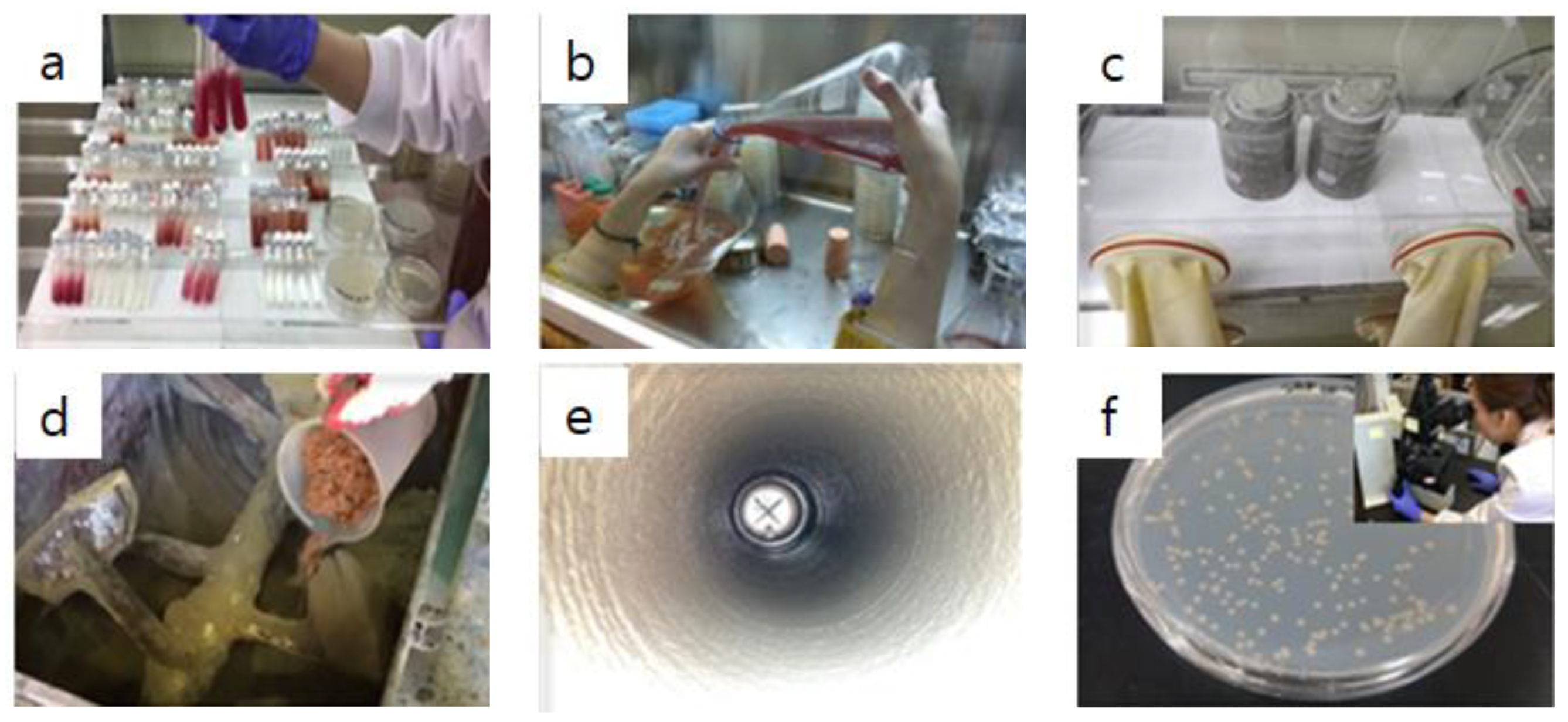
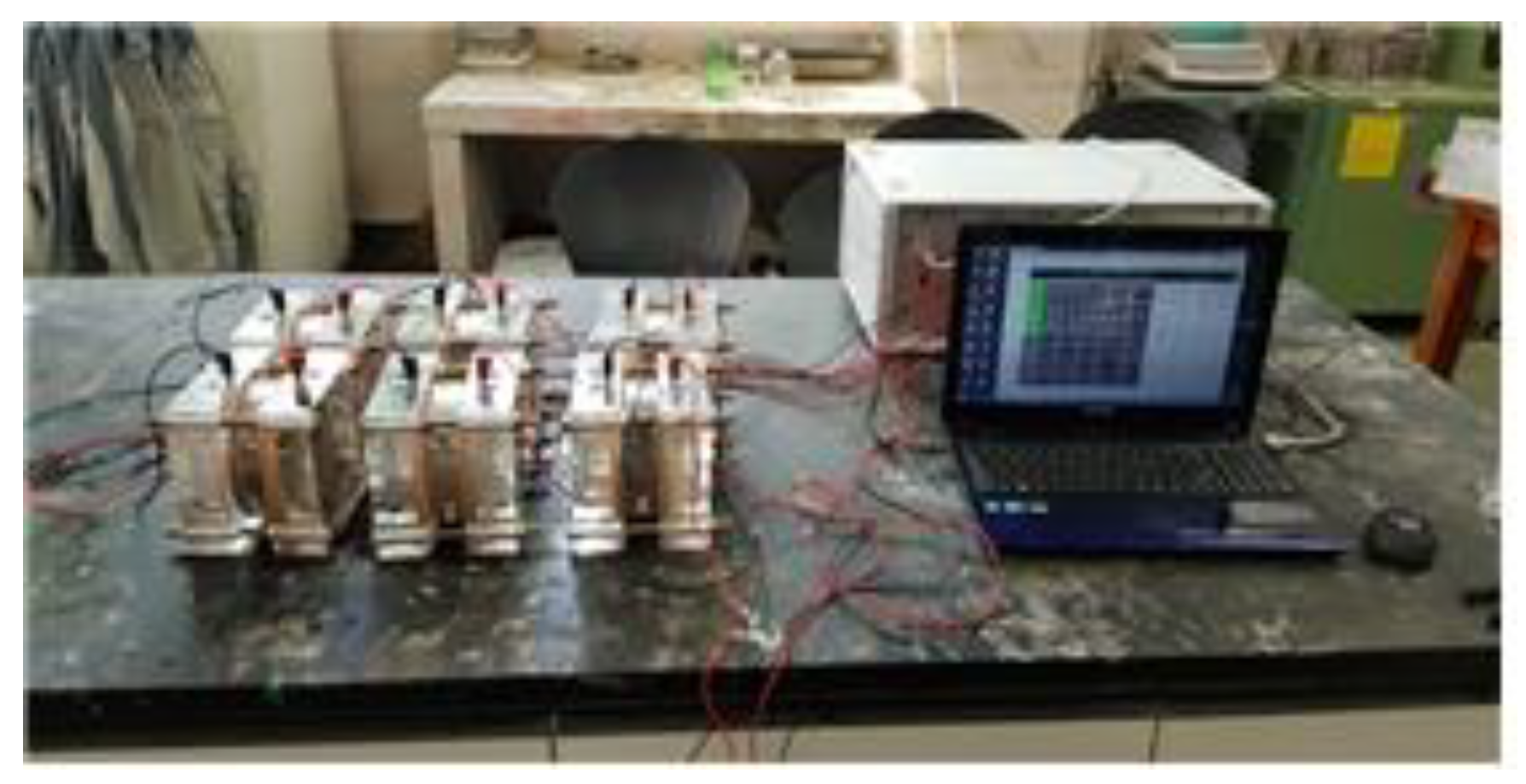
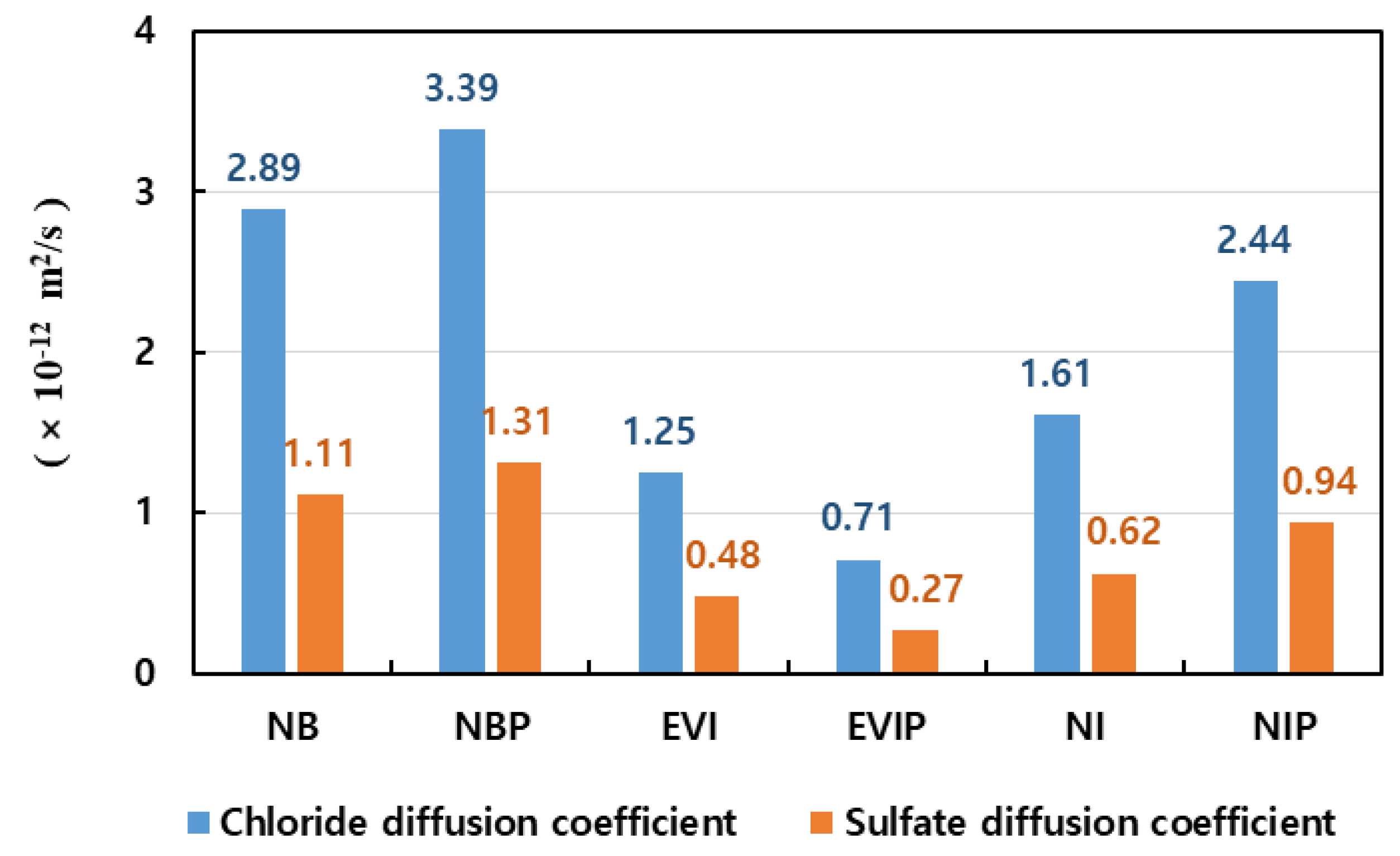

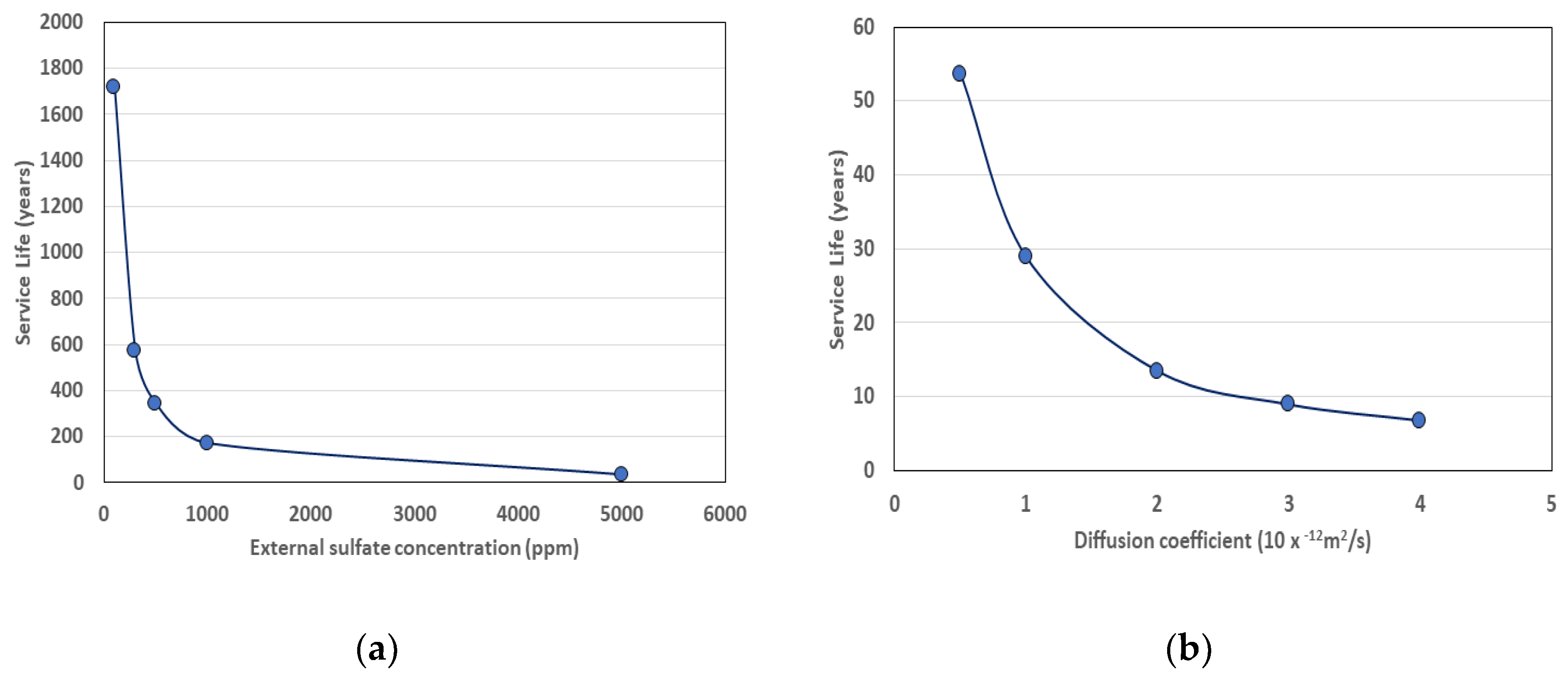
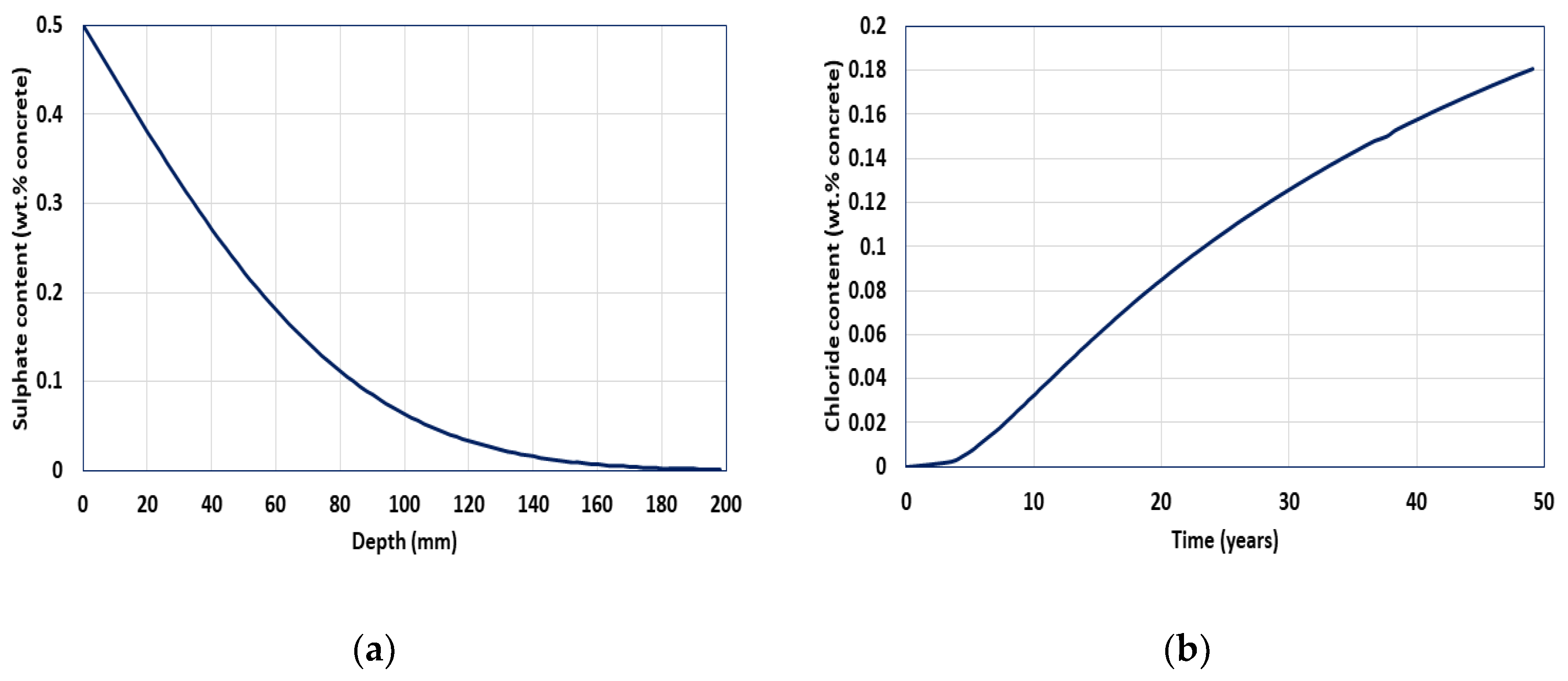
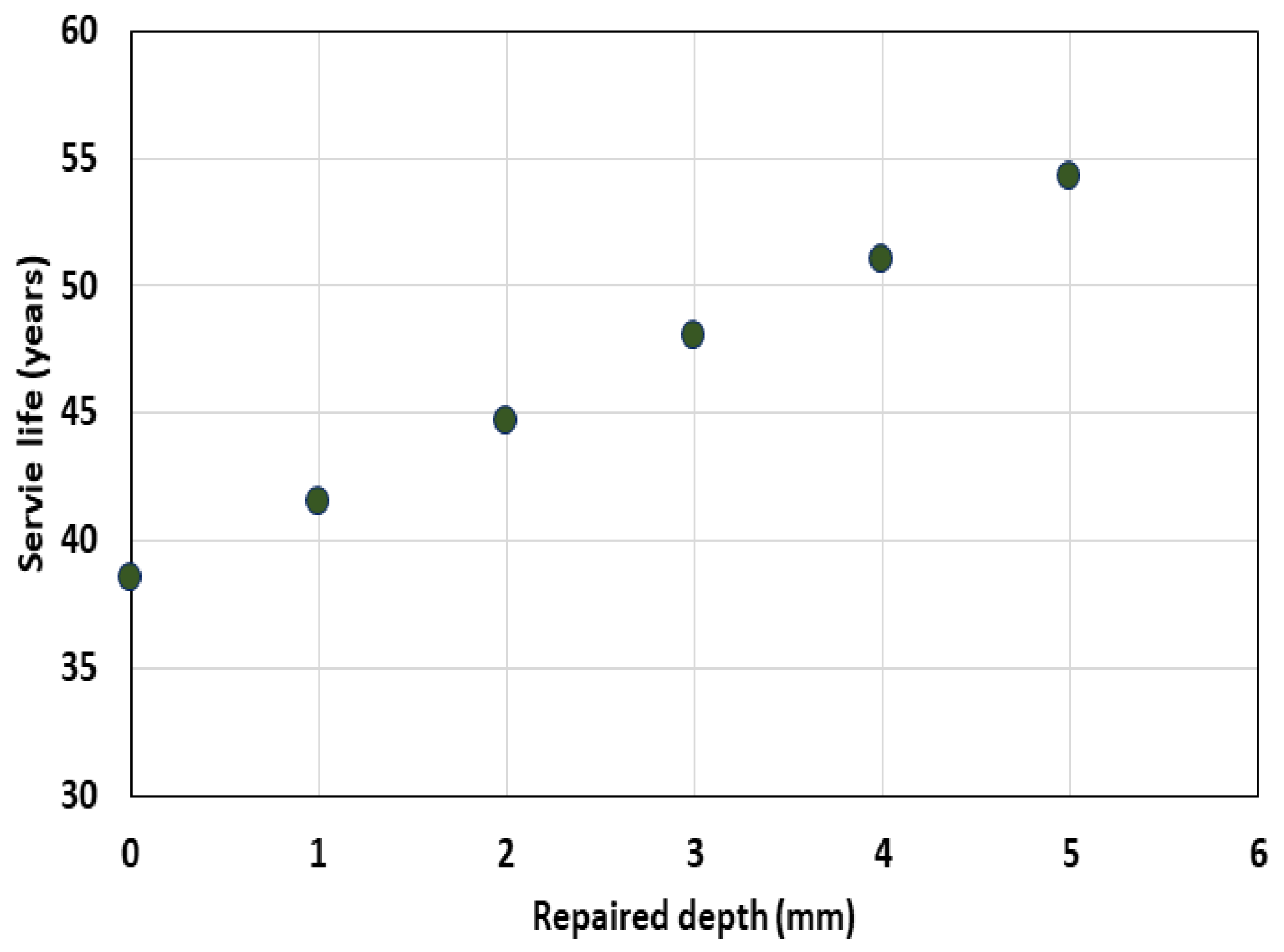
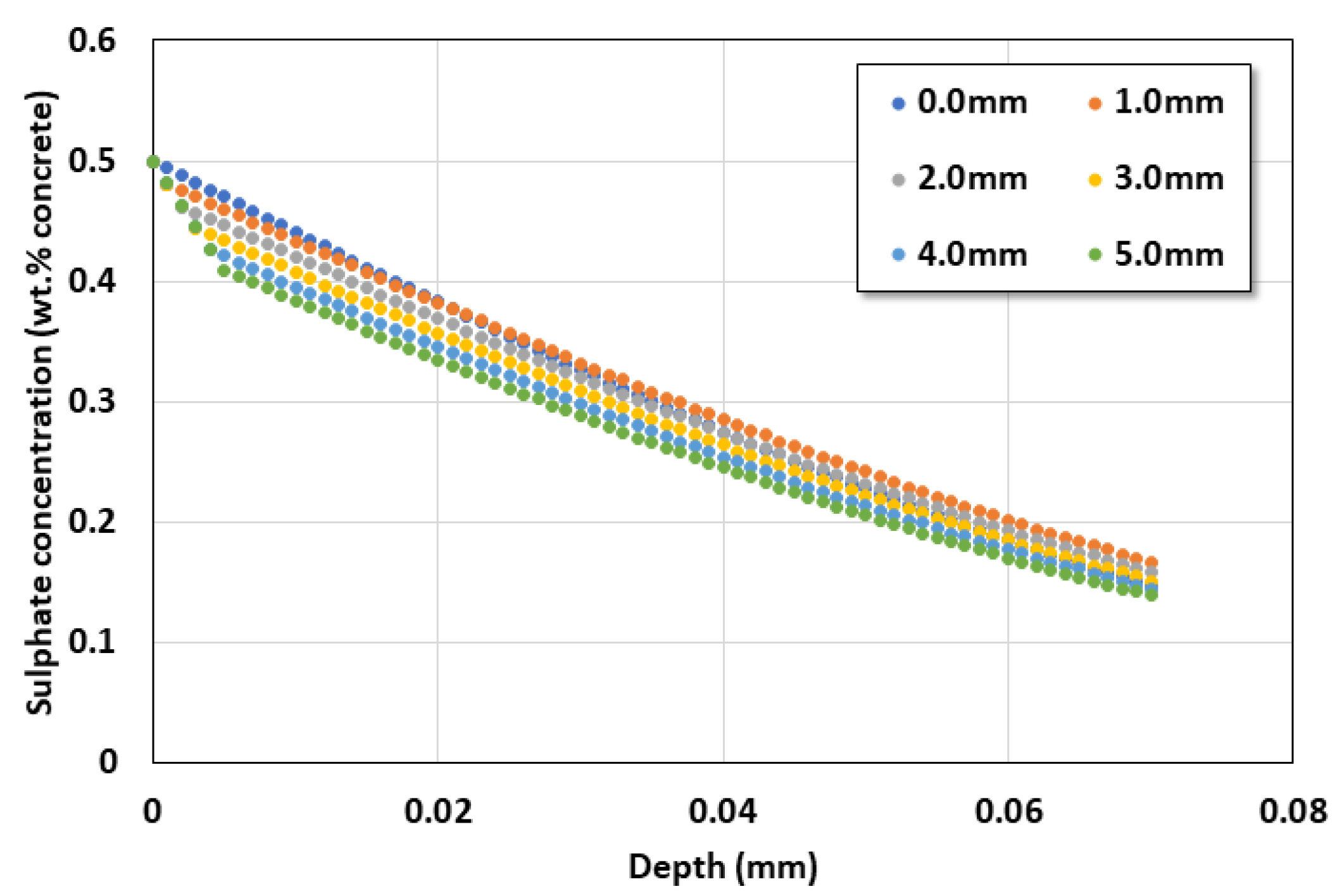
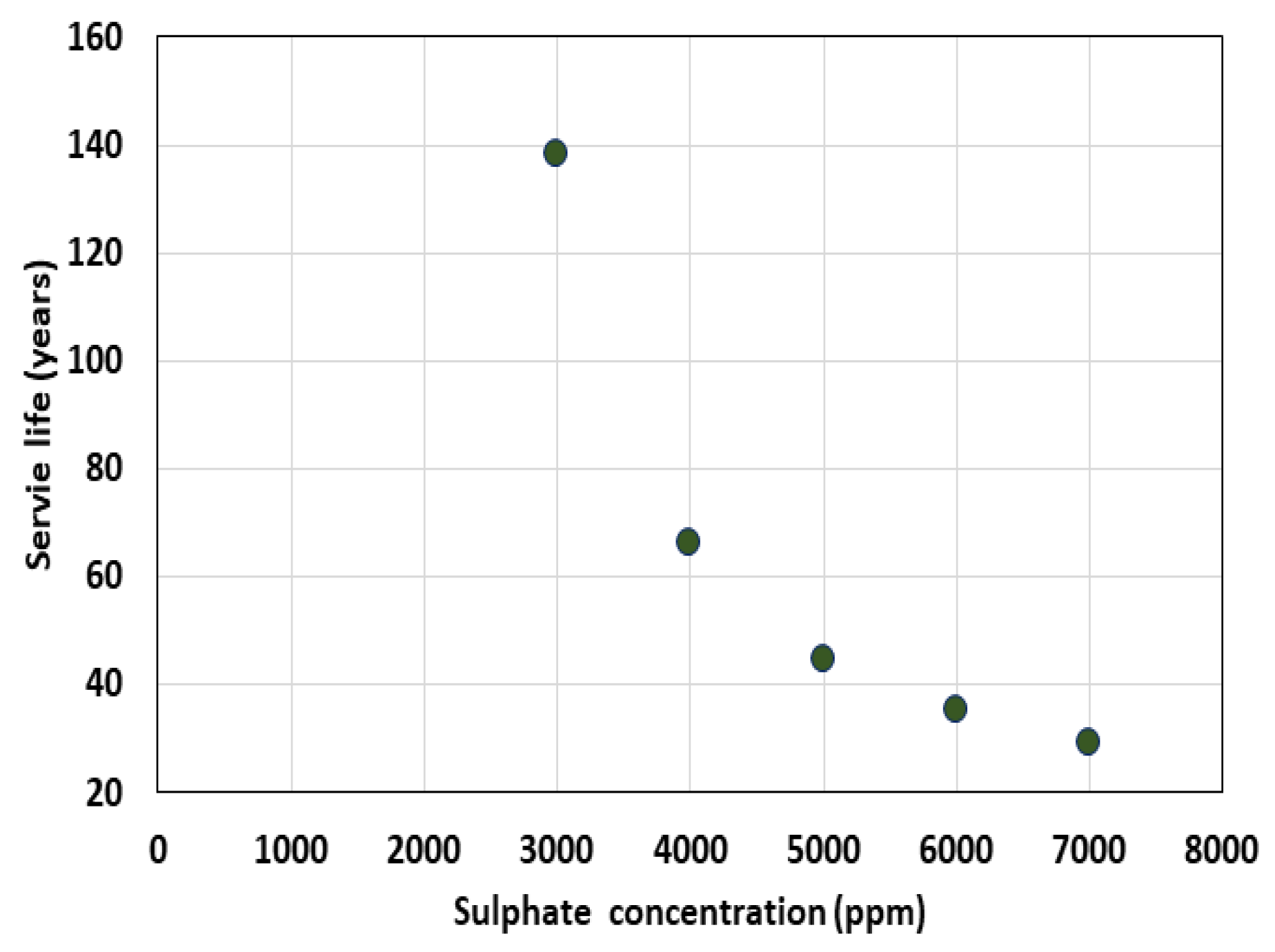
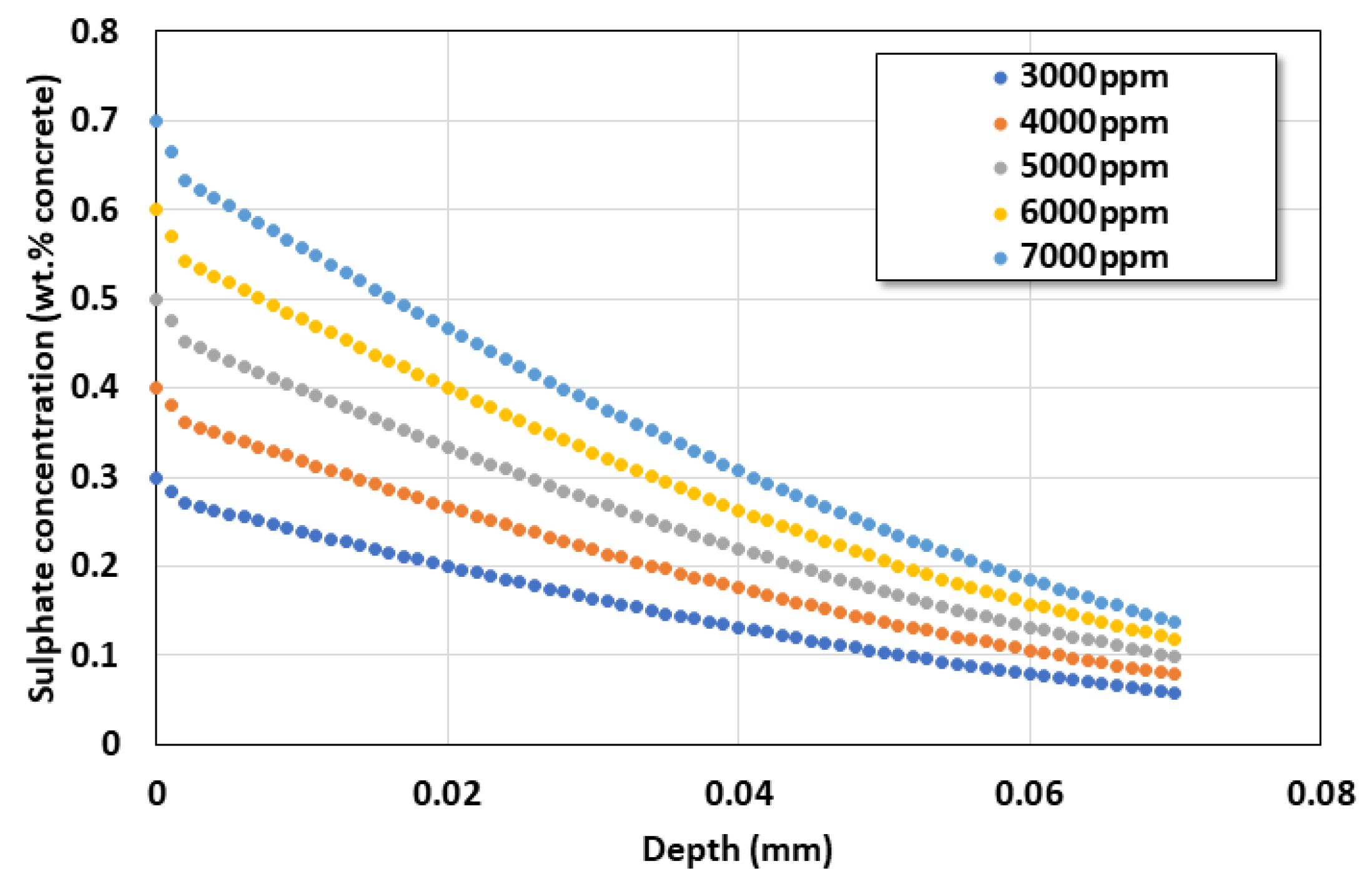
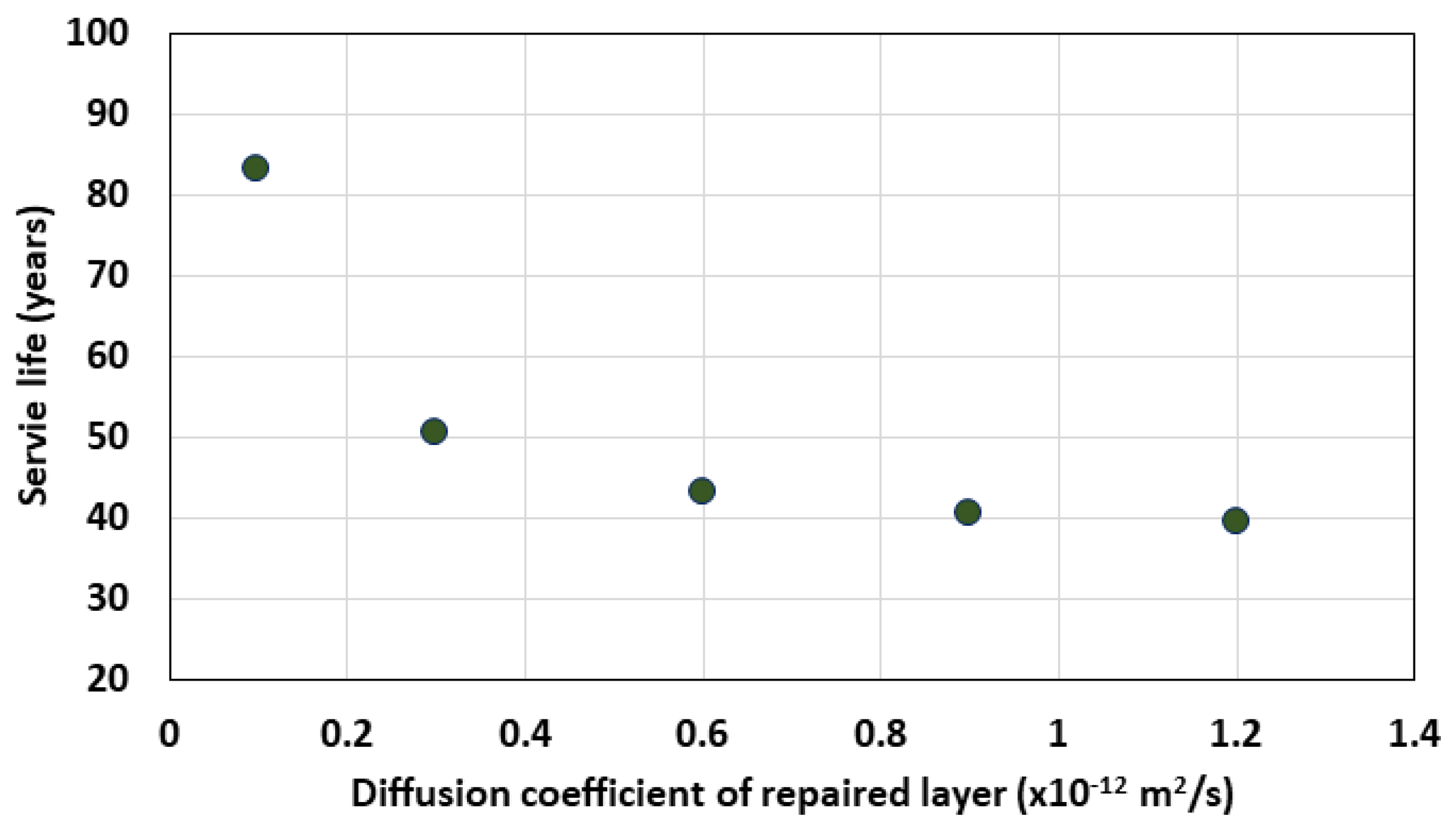
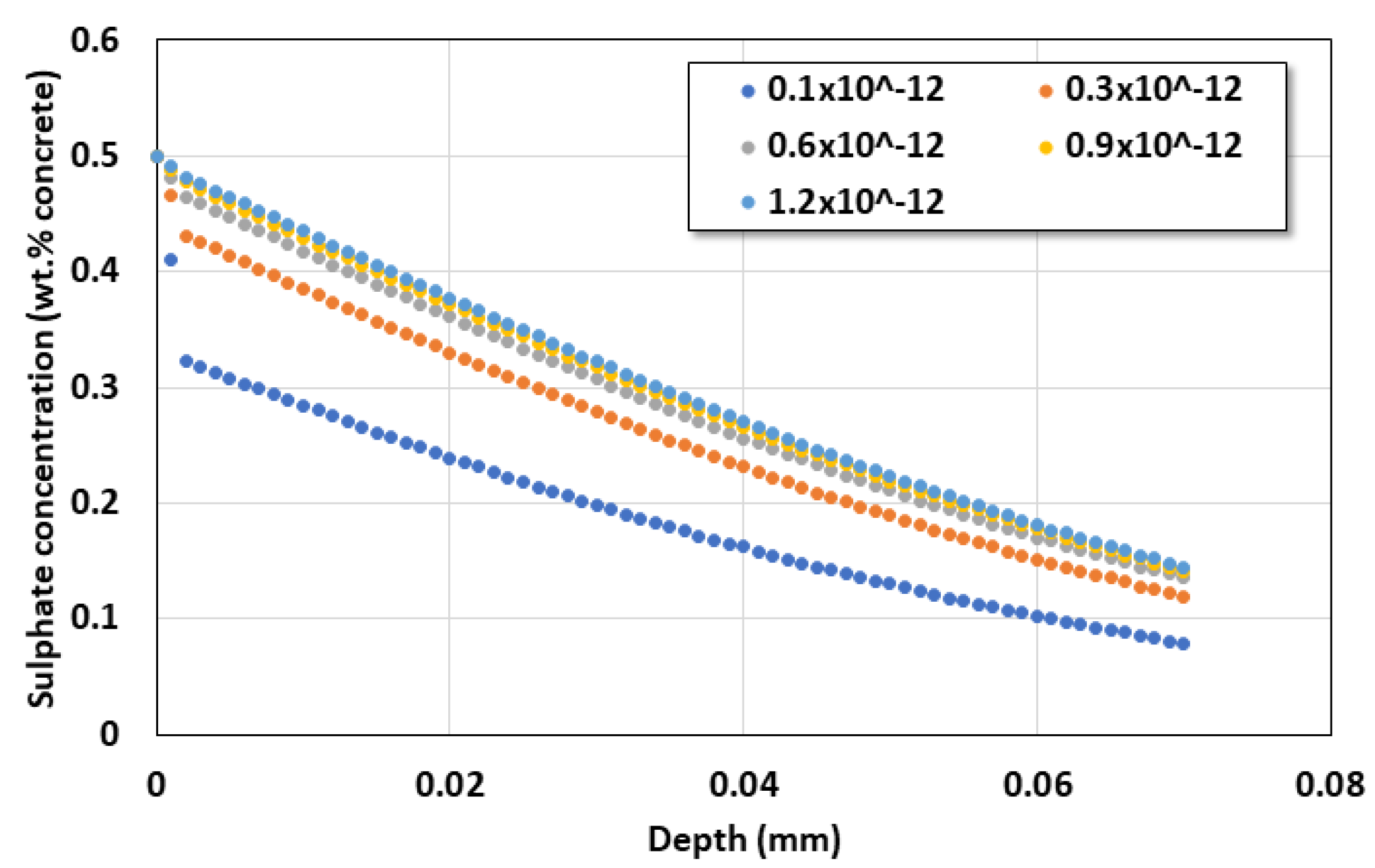
| W/B | S/B | Unit Weight (kg/m3) | ||||||
|---|---|---|---|---|---|---|---|---|
| Water | OPC | FA | GGBS | Silica Sand Size (mm) | ||||
| 0.05~0.17 | 0.17~0.25 | 0.25~0.7 | ||||||
| 35 | 2 | 135.9 | 158.5 | 90.6 | 203.8 | 196.3 | 196.3 | 196.3 |
| Sample | Strain | Immobilization Material Type | Immobilization Material Substitution Ratio (%) |
|---|---|---|---|
| Non-bacteria | − | − | − |
| Non-immobilized bacteria | Rhodobacter capsulatus | − | − |
| Expanded vermiculite (EV) immobilized bacteria | EV | 30 | |
| Super absorbent polymer (SAP) immobilized bacteria | SAP | 30 |
| Item | Value |
|---|---|
| Exterior sulfate concentration (%) | 5000 ppm |
| Diffusion coefficient in concrete | 7.943 × 10−12 m2/s |
| Critical sulfate concentration | 0.18% (1800 ppm) |
| Diffusion coefficient in slime-coating | 0.60 × 10−12 m2/s |
| Thickness of slime coating layer | 1.0~5.0 mm |
| Input variable | Unit | Input value | Ground |
|---|---|---|---|
| c0 | mol/m³ | 52.067 | 5000 ppm sulfate concentration was converted into the molar weight (96.06 g/mol) |
| Di | m²/s | 0.7 × 10−12 | Mean value of typical sulfate diffusion coefficients ((0−4) × 10−12 m2/s) based on the results of previous studies |
| E | Pa | 27,800 × 106 | Typical elastic modulus of concrete |
| ν | − | 0.177 | Typical Poisson’s ratio |
| x | kg/m3 | 289.1 | The amount of cement used in the mix design was used (slag substitution rate: 30%). |
| ΦAl2O3 | mol/m³ | 0.05 | The mean value of cement manufacturers was used. |
© 2020 by the authors. Licensee MDPI, Basel, Switzerland. This article is an open access article distributed under the terms and conditions of the Creative Commons Attribution (CC BY) license (http://creativecommons.org/licenses/by/4.0/).
Share and Cite
Yang, K.-H.; Lim, H.-S.; Kwon, S.-J. Effective Bio-Slime Coating Technique for Concrete Surfaces under Sulfate Attack. Materials 2020, 13, 1512. https://doi.org/10.3390/ma13071512
Yang K-H, Lim H-S, Kwon S-J. Effective Bio-Slime Coating Technique for Concrete Surfaces under Sulfate Attack. Materials. 2020; 13(7):1512. https://doi.org/10.3390/ma13071512
Chicago/Turabian StyleYang, Keun-Hyeok, Hee-Seob Lim, and Seung-Jun Kwon. 2020. "Effective Bio-Slime Coating Technique for Concrete Surfaces under Sulfate Attack" Materials 13, no. 7: 1512. https://doi.org/10.3390/ma13071512
APA StyleYang, K.-H., Lim, H.-S., & Kwon, S.-J. (2020). Effective Bio-Slime Coating Technique for Concrete Surfaces under Sulfate Attack. Materials, 13(7), 1512. https://doi.org/10.3390/ma13071512





